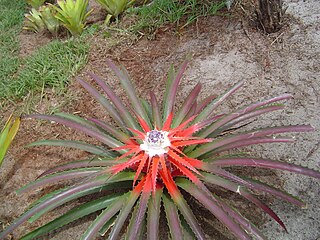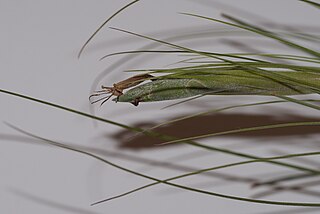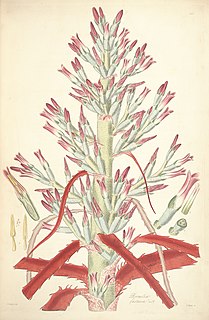
Bromelia is the type genus of the plant family Bromeliaceae, subfamily Bromelioideae. Bromelia species are widespread across much of Latin America and the West Indies, and are characterized by flowers with a deeply cleft calyx. The genus is named after the Swedish medical doctor and botanist Olof Bromelius (1639-1705).

Cryptanthus is a genus of flowering plants in the family Bromeliaceae, subfamily Bromelioideae. The genus name is from the Greek cryptos (hidden) and anthos (flower). This genus has two recognized subgenera: the type subgenus and HoplocryptanthusMez. All species of this genus are endemic to Brazil. The common name for any Cryptanthus is "Earth star".
Bromelia binotii is a plant species in the genus Bromelia. This species is endemic to Brazil.

Neoregelia carolinae or Blushing Bromeliad is a species in the genus Neoregelia. It is noted for its centre turning red when it's about to flower, from where the common name (Blushing) is derived. This species is endemic to Brazil.

Neoregelia concentrica is a species of bromeliad in the genus Neoregelia. This species is endemic to Brazil.

Tillandsia brachyphylla is a species of flowering plant in the Bromeliaceae family. This species is endemic to Brazil.

Bromelia antiacantha is a plant species in the genus Bromelia. This species is native to Brazil and Uruguay.

Bromelia balansae is a plant species in the genus Bromelia. This species is native to Argentina, Brazil, Colombia, Bolivia, and Paraguay where it grows at elevations of 150 to 3,000 feet.

Bromelia karatas is a plant species in the genus Bromelia. This species is native to West Indies and to Latin America from San Luis Potosí + Sinaloa south to Brazil.
Bromelia regnellii is a plant species in the genus Bromelia. This species is native to Brazil.

Tillandsia gardneri is a species in the genus Tillandsia. This species is native to Trinidad & Tobago, Colombia, eastern Brazil and Venezuela.

Tillandsia geminiflora is a species in the genus Tillandsia. This species is native to Brazil, Suriname, Paraguay, Uruguay, and the Misiones Province of Argentina.

Tillandsia juncea is a species in the genus Tillandsia. This species is native to northern South America, Central America, Mexico and the West indies.
Tillandsia paraensis is a species in the genus Tillandsia. This species is native to Bolivia, Peru, Ecuador, Colombia, the Guianas, Brazil and Venezuela.

Tillandsia recurvifolia is a species in the genus Tillandsia. This species is native to Bolivia, Paraguay, Uruguay, Argentina, and Brazil.

Tillandsia tenuifolia, the narrowleaf airplant, is a species in the genus Tillandsia. This species is widespread across much of South America and the Caribbean islands.

Vriesea procera is a plant species in the genus Vriesea. This species is an epiphyte native to Trinidad and South America.

Bromelia pinguin is a plant species in the genus Bromelia. This species is native to Central America, Mexico, the West Indies and northern South America. It is also reportedly naturalized in Florida. It is very common in Jamaica, where it is planted as a fence around pasture lands, on account of its prickly leaves. The fruit, known as piñuela, is dug out, protective "hair" removed, peeled like a banana, and eaten. They are slightly tart with a crunch from the seeds. The plant can be stripped of its pulp, soaked in water, and beaten with a wooden mallet, and it yields a fiber whence thread is made. In countries like El Salvador, it is used to make gruel.
Bromelia goeldiana is a plant species in the genus Bromelia. This species is native to Venezuela and Brazil.

Bromelia laciniosa, natively known as macambira, is plant in the bromeliad family, or in other words, the pineapple family—though not all bromeliads resemble the common pineapple. As a family, the histories of bromeliads have been well recorded, but the details of its many species, like Bromelia laciniosa, are not known. Bromelia laciniosa is native to Brazil and Argentina but cultivated in many other places.














